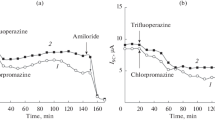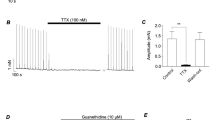Abstract
In adult amphibian skin, Na+ crosses from outside to inside. This Na+ transport can be measured as the amiloride-blockable short-circuit current (SCC) across the skin. We investigated the effects of arginine vasotocin (AVT) and mesotocin (MT), and those of antagonists of the vasopressin and oxytocin receptors, on the SCC across Hyla japonica skin. (1) Both AVT (100 pmol/L or more) and MT (1 nmol/L or more) increased the SCC. (2) The AVT- and MT-induced increases in SCC recovered with time (downregulation). (3) These AVT/MT-induced effects were blocked by application of OPC-31260 (vasopressin V2-receptor antagonist). (4) The OPC-31260 concentration needed to block the AVT-induced response was lower upon post-application (after application of agonist) than upon pre-application (before application of agonist), suggesting the number of receptors may have decreased after AVT application. (5) Upon repeated application of AVT (100 pmol/L), the induced SCC increase did not differ significantly between the 1st and 2nd applications. (6) The time to reach the half-maximum value of the AVT-induced or MT-induced increase in SCC was not significantly different between washout and post-application of OPC-31260, suggesting that post-application of OPC-31260 cleared AVT and MT from their receptors. The effects of AVT, MT, and their antagonists in H. japonica, which is adapted to a terrestrial habitat, are compared with our previously published data on Rana catesbeiana (=Lithobates catesbeianus), which is adapted to a semiaquatic habitat.









Similar content being viewed by others
References
Acher R, Chauve J, Chauvet M-T, Rouille Y (1999) Unique evolution of neurohypophysial hormones in cartilaginous fishes: possible implications for urea-based osmoregulation. J Exp Zool 284:475–484
Akhundova A, Getmanova E, Gorbulev V, Carnazzi E, Eggena P, Fahrenholz F (1996) Cloning and functional characterization of the amphibian mesotocin receptor, a member of the oxytocin/vasopressin receptor superfamily. Eur J Biochem 237:759–767
Birnbaumer M, Antaramian A, Themmen APN, Gilbert S (1992) Desensitization of the human V2 vasopressin receptor. J Biol Chem 267:11783–11788
Bouley R, Lin HY, Raychowdhury MK, Marshansky V, Brown D, Ausiello DA (2005) Downregulation of the vasopressin type 2 receptor after vasopressin-induced internalization: involvement of a lysosomal degradation pathway. Am J Physiol Cell Physiol 288:C1390–C1401
de la Rosa DA, Li H, Canessa CM (2002) Effects of aldosterone on biosynthesis, traffic, and functional expression of epithelial sodium channels in A6 cells. J Gen Physiol 119:427–442
Ecelbarger CA, Kim G-H, Terris J, Masilamani S, Mitchell C, Reyes I, Verbalis JG, Knepper MA (2000) Vasopressin-mediated regulation of epithelial sodium channel abundance in rat kidney. Am J Physiol Renal Physiol 279:F46–F53
Eggena P, Lu M, Buku A (1990) Internalization of fluorescent vasotocin-receptor agonist and antagonist in the toad bladder. Am J Physiol 259:C462–C470
Féraille E, Doucet A (2001) Sodium–potassium–adenosinetriphosphatase-dependent sodium transport in the kidney: hormonal control. Physiol Rev 81:345–418
Franco R, Casadó V, Cortés A, Ferrada C, Mallol J, Woods A, Lluis C, Canela EI, Ferré S (2007) Basic concepts in G-protein-coupled receptor homo- and heterodimerization. Sci World J 7(S2):48–57
Frost DR, Grant T, Faivovich J, Bain RH, Haas A, Haddad CFB, de Sá RO, Channing A, Wilkinson M, Donnellan SC, Raxworthy CJ, Campbell JA, Blotto BL, Moler P, Drewes RC, Nussbaum RA, Lynch JD, Green DM, Wheeler WC (2006) The amphibian tree of life. Bull Am Mus Nat Hist 297:1–371
Garty H, Edelman IS (1983) Amiloride-sensitive trypsinization of apical sodium channels. J Gen Physiol 81:785–803
Hayslett JP, Macala LJ, Smallwood JI, Kalghatgi L, Gassala-Herraiz J, Isales C (1995) Vasopressin-stimulated electrogenic sodium transport in A6 cells is linked to a Ca2+-mobilizing signal mechanism. J Biol Chem 270:16082–16088
Hoyle CHV (1999) Neuropeptide families and their receptors: evolutionary perspectives. Brain Res 848:1–25
Kleyman TR, Ernst SA, Coupaye-Gerard B (1994) Arginine vasopressin and forskolin regulate apical cell surface expression of epithelial Na+ channels in A6 cells. Am J Physiol 266:F506–F511
Kohno S, Kamishima Y, Iguchi T (2003) Molecular cloning of an anuran V2 type [Arg8] vasotocin receptor and mesotocin receptor: functional characterization and tissue expression in the Japanese tree frog (Hyla japonica). Gen Comp Endocrinol 132:485–498
Lutz W, Sanders M, Salisbury J, Kumar R (1990) Internalization of vasopressin analogs in kidney and smooth muscle cells: Evidence for receptor-mediated endocytosis in cells with V2 or V1 receptors. Proc Natl Acad Sci USA 87:6507–6511
Marunaka Y, Eaton DC (1991) Effects of vasopressin and cAMP on single amiloride-blockable Na channels. Am J Physiol 260:C1071–C1084
Mohan S, Bruns JR, Weixel KM, Edinger RS, Bruns JB, Kleyman TR, Johnson JP, Weisz OA (2004) Differential current decay profiles of epithelial sodium channel subunit combinations in polarized renal epithelial cells. J Biol Chem 279:32071–32078
Pang PKT, Sawyer WH (1978) Renal and vascular responses of the bullfrog (Rana catesbeiana) to mesotocin. Am J Physiol 235:F151–F155
Pfeiffer R, Kirsch J, Fahrenholz F (1998) Agonist and antagonist-dependent internalization of the human vasopressin V2 receptor. Exp Cell Res 244:327–339
Rossier BC (2002) Hormonal regulation of the epithelial sodium channel ENaC: N or Po? J Gen Physiol 120:67–70
Takada M, Fujimaki-Aoba K, Hokari S (2010) Effects of arginine vasotocin and mesotocin on the activation and development of amiloride-blockable short-circuit current across larval, adult, and cultured larval bullfrog skins. J Comp Physiol B 180:393–402
Terrillon S, Durroux T, Mouillac B, Breiy A, Ayoub MA, Taulin M, Jo Kers R, Barberis C, Bouvier M (2003) Oxytocin and vasopressin V1a and V2 receptors form constitutive homo- and heterodimers during biosynthesis. Mol Endocrinol 17:677–691
Weisz OA, Wang JM, Edinger RS, Johnson JP (2000) Non-coordinate regulation of endogenous epithelial sodium channel (ENaC) subunit expression at the apical membrane of A6 cells in response to various transporting conditions. J Biol Chem 275:39886–39893
Yamada T, Nishio T, Sano Y, Kawago K, Matsuda K, Uchiyama M (2008) Effects of arginine vasotocin and vasopressin receptor antagonists on Na+ and Cl− transport in the isolated skin of two frog species, Hyla japonica and Rana nigromaculata. Gen Comp Endocrinol 157:63–69
Yu L, Helms MN, Yue Q, Eaton DC (2008) Single-channel analysis of functional epithelial sodium channel (ENaC) stability at the apical membrane of A6 distal kidney cells. Am J Physiol Renal Physiol 295:F1519–F1527
Acknowledgments
All procedures complied with the relevant Japanese law governing animal experimentation (Law No. 105, Notification No. 000398). We are greatly indebted to Dr. Toyoki Mori and his co-workers at Otsuka Pharmaceutical Co. Ltd. for their gifts of OPC-21268 and OPC-31260. This research was supported in part by a Saitama Medical University Internal Grant (No. 21-1-2-11).
Author information
Authors and Affiliations
Corresponding author
Additional information
Communicated by G. Heldmaier.
Rights and permissions
About this article
Cite this article
Takada, M., Fujimaki-Aoba, K. & Hokari, S. Vasotocin- and mesotocin-induced increases in short-circuit current across tree frog skin. J Comp Physiol B 181, 239–248 (2011). https://doi.org/10.1007/s00360-010-0523-5
Received:
Revised:
Accepted:
Published:
Issue Date:
DOI: https://doi.org/10.1007/s00360-010-0523-5




